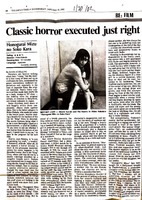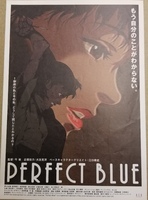Target User Group
Primary Users
Since film is a gateway to culture and studying our archive will provide a window into Japanese culture, our team believes that our primary user group is interested in learning about Japanese culture and horror film aesthetics. Additionally, after our interview with Mark Schilling, our observations, and external research, we can make a few more assumptions about our primary audience. For instance, we believe that many members of our target audience are aspiring film critics, filmmakers, researchers, and academics.
For academics, they would primarily be interested in studying the intersection of film and culture. Our team believes that there is a hole in the academic discourse around horror films and recognition of their cultural impact. Thus this particular group of users will hopefully be interested in demonstrating the long-term value of horror films as cultural material.
Some viewers, such as those interested in breaking into the J-horror or Japanese film industry, may be Japanese themselves. According to Schilling, "as of late, Japan is attracting many foreign directors. And the industry is recognizing more women directors" (Schilling, 2020). This observation suggests that the industry's demographics are changing, albeit slowly. This group is relatively niche compared to our secondary and tertiary users.
Secondary Users
This group of potential users are individuals interested in general film, culture, or sound studies. You may find these people hanging out at film or movie clubs. In terms of age demographics, this group may primarily be college students engaging with collections in some capacity. Movie studio workers seeking to understand a particular genre (in this case, horror) may also wish to engage with our archive. Lastly, as our collection has some cultural importance, users who work with museums might find value and want to engage in our archive.
Tertiary Users:
These individuals comprise the largest user group who could potentially be interested in our archive. They are causal film members and the types to see a movie when it is first released. Still, many aren't interested in joining fan clubs or staying up to date on current film trends either locally or globally.
User Needs
In general, the purpose of this online archive is for it to be a starting place for people to learn about a few of Japan's most famous directors, especially from a horror genre angle. Our users may also be interested in finding material that is digitally accessible if they cannot physically access the collection. As we would like to create an archive that gathers Japanese horror production resources, it would ideally be a convenient source of stills, scripts, interviews with the filmmakers, and more. Some users might want to know about the film making process, the source of a director's inspiration, or the filming location's importance.
Our primary user group will also find this archive useful since they are interested in Japanese culture and film. Specifically, we hope they will utilize our online archive to review and study previously overlooked materials. We also hope to increase their exposure to an understudied genre of film. Our team wanted to have a highly detailed finding aid for our academic users since they are the group most likely to engage with the archive and to not be passive users. From the Yakel reading, our team found that administrative users will not use finding aids and were instead passive archival users; they only engaged with the archive for specific answers (1994). We hope that most of our users will come to the archive to actively learn about Japanese culture.
Our secondary users are most interested in understanding film, culture, and sound studies. So this archive would serve as a good starting point for anyone interested in a particular director. They would be most interested in the "Collection Highlights" pages because that section has the most visuals and information about the directors.
Our tertiary group of users is most interested in just learning something new about film. However, because they might not be as interested in film aesthetics or Japanese culture in general, it is unlikely that many will use this archive. Still, they would likely find the "Collection Highlights" pages the most interesting since they are the most broadly appealing within our site.
Addressing User Needs
Our users will need us to provide as much cultural context as possible for our items. We will not be able to showcase films without building a narrative around the cultural origins and impacts. Mattock and Mattern's article, "Looking at Archives in Cinema: Recent Representations of Records in Motion Pictures," argues that the way archivists represent records dictates how individuals understand real-world events. Since our team wants to engage with topics such as the nuclear attacks on Japan, we must provide full social context to our users to give a correct and clear understanding of history.

